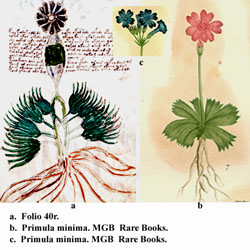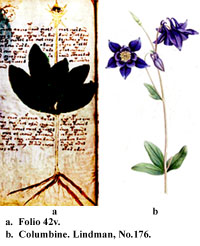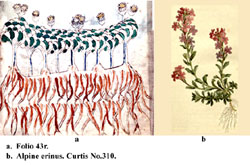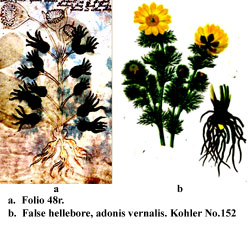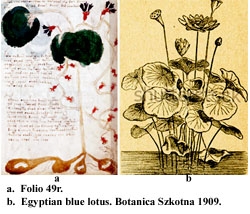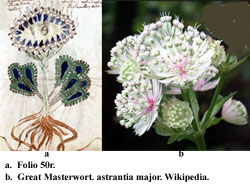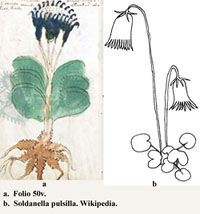The Voynich Botanical Plants
Folio 40r. Primula minima is a small primrose that grows in large mats in the mountainous habitats in the Dolomites in Italy. This is another alpine plant. (C)
Folio 42v. Columbine (Aqulegia vulgaris). This is a different species of columbine. Unlike aqulegia alpina (Folio 18v), this species does not have palmate-shaped leaves. (C)
Folio 43r. Alpine balsum (Erinus alpinus) is a small perennial evergreen with rose-pink flowers native to the alpine regions of southern and central Europe. (C)
Folio 45v. Lavender (Lavendula officinulis). Lavender was a treasured herb in the Middle Ages, it was used to “perfume the clothes of the rich and was strewn in the chests to keep away the insects. If the head is sprinkled with lavender water it will make that person chaste for as long as he keeps it on him. For the headache,” Hortus Sanitatis recommends to “take the flowers of lavandula stoeches and put them in a little bag along with bay and betony, red roses and marjoram, clove, pinks and nutmeg blossom. … If this little bag is put on the head it will soothe all pain. Lavender also had strange unspeakable virtue against apoplexy, palsy and loss of speech.” (2) (C)
Folio 46v. Ploughman’s Spikenard / Great Fleabane (Inula conyza), is native to Europe, Asia, and Africa. The name Inula dates back to the Romans. This is a tall, rather plain plant, with a biennial root, oval leaves resembling those of a foxglove, and clusters of rayless, dull, yellow flowers. A decoction of Ploughman’s Spikenard was frequently used for bruises, ruptures, and internal wounds; the juice from the plant was used to soothe itchy skin. The leaves were burnt as an insecticide to destroy fleas. (C)
Folio 48r. False hellebore (Adonis vernalis) is found in the drier regions of southern Europe. The plant is poisonous, containing compounds similar to those in digitalis for stimulating the heart, but its action is stronger and is said not to be cumulative. (C)
Folio 49r, Blue Nile Lotus (Nymphaea caerulea). This water lily is the sacred flower of ancient Egypt. The blue flowers rise and open above the surface of the water in the morning and in the evenings close and sink again. The ancient Egyptians equated this behavior with that of their sun god Isis. According to the Odyssey, the Lotus Eaters were a happy, indolent people as a result of eating the blue Nile lotus for its soporific and psychedelic effects. When Odysseus landed among them, some of his men ate their food. They forgot their friends and home and had to be dragged back to the ships. (C)
Folio 50r. Masterwort (Astrantia major), is a native of the eastern Mediterranean and West Asia. According to the 17th century English physician and herbalist, Culpepper, its black woody rhizome is hotter than pepper, and useful for treating colds and diseases of the stomach. (C)
Folio 50v. Soldanella pulsitilla. The genus Soldanella, commonly known as snowbell, includes about 15 species that grow in woods and damp pastures in the Pyrennes, Apennine Mountains and the Alps (1). It is one of the herbs in Jacob Meydenbach’s Ortus Sanitatis. (C)
Folio 51r. European Searocket (Cakile maritima) is a member of the mustard family. It is widespread in Europe, especially on coastlines where it grows in clumps on the sand dunes. The young plant may be cooked or used in salads. (C)
